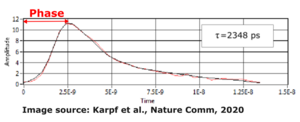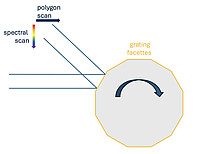Bachelor- and Master Thesis
At our institute, there are almost always ideas or smaller projects that can be worked on as part of a bachelor's thesis, an internship or as a working student. For more advanced students, we are also happy to offer Master's thesis topics. You can find our current topics for student theses and topics from other BMO working groups below. The specific questions can be worked out in a personal discussion.
If no suitable positions are currently advertised for you, but you would still like to write your thesis at the institute, please contact us. We are sure to find a solution for particularly motivated and interested students!
The research group leaders and doctoral students will be happy to help you.
If you are interested, please send the contact person a CV and a current transcript of records with your enquiry.
Development of a polygon grid scanner
AG Karpf – Master Thesis
The SLIDE microscopy method researched by the Karpf working group is one of the fastest two-photon microscopes in the world. Diffraction gratings and galvo mirrors are currently used as scanning elements. The aim of this master's thesis is to develop a polygon scanner with grating facets. To this end, the turntable is to be 3D printed, the gratings glued to the facets, and the phase and frequency of rotation locked to the sweep rate of the FDML-MOPA laser. The target image scan rates are 3kHz.
Please contact: Sebastian Karpf
Development of a Python-based correction algorithm for bi-directional scanned SLIDE microscopy
AG Karpf - Bachelor Thesis

SLIDE microscopy is a new, high-speed microscopy method for in vivo imaging. Using a new spectral scanning mechanism and bi-directional galvo and piezo scanning techniques, acquisition rates of 40 volumes per second are achieved, i.e. approx. 100 times faster than conventional scanning microscopy. Currently, the phase of the scan elements has to be adjusted manually. In this work, a correction algorithm is to be developed in napari (Python-based) that recognizes and automatically corrects image artefacts caused by incorrect phase (so-called zippers). In addition, the phase position of the fluorescence curves is to be analyzed using a global FLIM curve.
Please contact: Sebastian Karpf
Real-time temperature control for laser irradiations on the retina of the eye
AG Brinkmann - Bachelor Thesis
As part of a DFG-funded project, a new laser setup is being created in which we want to heat the retina with only one laser and measure the temperature increase in real time in parallel. The bachelor thesis includes optimisation of the setup, measurements on retina explants of pig eyes, and real-time recording and processing of the data. Cell vitality assays will be used to obtain a comparison of thermal damage as a function of temperature.Requirements: Experimental skills and programming experience.
If you are interested, please contact: Ralf Brinkmann
Set-up of Fourier ptychogaphic imaging and evaluation using machine learning
AG Rahlves - Master Thesis
Fourier ptychography is a high-resolution imaging method in which intensity images of a sample are acquired under coherent illumination at different angles of illumination. From the individual images, both a higher resolution image and the object phase can be reconstructed numerically without the need for interferometric images. This requires so-called phase retrieval algorithms for image reconstruction, such as the Gerchberg-Saxton algorithm. Alternatively, however, machine learning methods are becoming increasingly established to enable reconstruction. The aim of the thesis is first to build a simple Fourier ptychography imaging system. However, the focus will be on the implementation and evaluation of machine learning-based evaluation, which will be realised in Python using PyTorch or TensorFlow, for example.
If you are interested, please contact: Maik Rahlves












